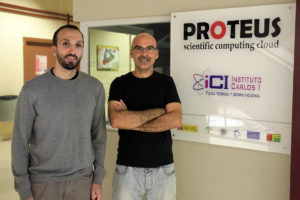PROTEUS Supercomputer
The PROTEUS supercomputer is the main service that the Carlos I Interuniversitary Institute of Theoretical and Computational Physics (iC1) offers to its members and collaborators. It provides an HPC (High Performance Computing) environment that contains the last innovations in computation and is optimized towards scientific calculus and simulations. It’s made up of a cluster of high performance nodes with cloud computing and cloud storage capabilities.
PROTEUS, since its inception, has had a great reception and demand, for which a constant series of improvements and extensions has been necessary.
A LITTLE BIT OF HISTORY
The supercomputing service is inaugurated on the iC1. At that time, there were 24 processors and a power of 200 GFLOPs. The runtime environment was based on MOSIX and user accounts were shared by NFS.
It was expanded to 48 processors, with a power of about 500 GFLOPs.
First big update. Considerable increase in power (160 processors and 1500 GFLOPs). Onboarding full-time technical staff introducing the Condor queue manager and the GlusterFS distributed file system.
New extension. We now have 600 processors and 5500 GFLOPs. As improvements to the environment, there are program restore points, data redundancy and secondary storage for backups.
Power is expanded to 1,100 processors and 13,000 GFLOPs. New to the system are better control over parallel programs with large memory needs, cloud storage and the addition of programmable graphics cards. The file system becomes CephFS-based.
Again, the number of processors and memory is expanded (1,300 processors and 27,000 GFLOPs). A low latency network, Infiniband FDR, is created that connects the last nodes for the execution of distributed jobs using MPI.
The management servers are reinforced so that the cluster is more robust against hardware failures, being able to continue operating despite the fact that these cause the fall of some nodes, obtained through the virtualization of the management nodes. The I / O backbone is enhanced with 10G connections. Backups are made on tapes. The LUSTER file system is created for high I / O rate and parallel writes.
New big update. 1100 new processors (2300 in total and 90000GFLOPs). Increased and improved file system capacity. Diskless execution nodes. Mathematica Licenses. SLURM queue manager. Lmod module environment.

APPS AND RESOURCES
PROTEUS is managed by GNU/Linux free software. Its architecture is Beowulf type, (used first by NASA and used widely nowadays, for example, by Google), which major advantage is that it can obtain a really high performance in a budget while needing just cheap maintenance.
The previous version of PROTEUS even got to overflow from its intense use, since scientists have been using its resources at 100% since it launched on 2008. Since then, it is in constant ampliation and improvement.
This success can be attributed to the management policies of PROTEUS, since it doesn’t force a time limit on process execution (some of them can even be executing for six months), and no memory or disk quotas are assigned. There’s an automatized manager (Condor) that, in case of saturation, prioritizes users that have used the cluster the least.
SUPERCOMPUTERS AND SCIENCE
Access to computation tools is fundamental for the proper development of researching activity in many fields of physics. Supercomputation allows to perform simulations with a high number of bodies and interactions, obtain statistics about them or test and refine theoretical models.
These simulations are commonly over what an ordinary computer can deal with, so it’s necessary to use a much more powerful system that can satisfy these scientific activities’ requirements.
For example, in physics, simulations are a must in fields like atmosphere physics, fluid dynamics or astrophysics, in which it is very hard to work at the scale and number of particles involved; or quantum physics, in which most systems do not allow an analytic solution.
Despite all of this, the importance of these kind of methods isn’t bound to the field of physics, since it’s greatly important in other fields of science in which the simulation process is fundamental, like when studying biological systems.
PROTEUS gives access to these fundamental tools for research for the great number of scientist that are part of the Carlos I Institute, helping with the progress of their scientific activities.
- AstrophysicsGalaxy and cosmology research
- Bioinformatycs and biophysicsADN, cell process dynamics
- NeuroscienceStudy of the brain and neural mediums
- Statistical physicsOut of equilibrium physics
- Social physicsPopulation dynamics
- Quantum physicsInformation theory, quantum computing
Do you have any questions?
It will be a pleasure to help you






